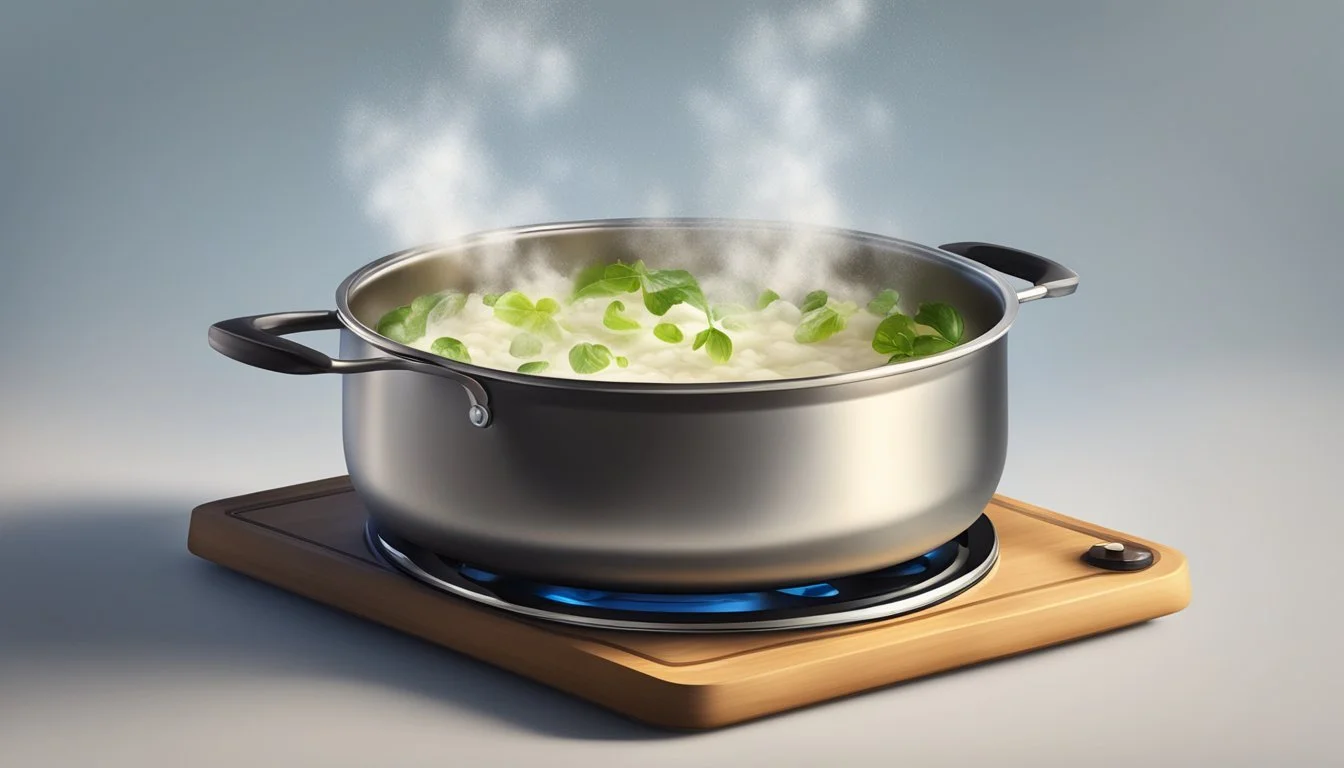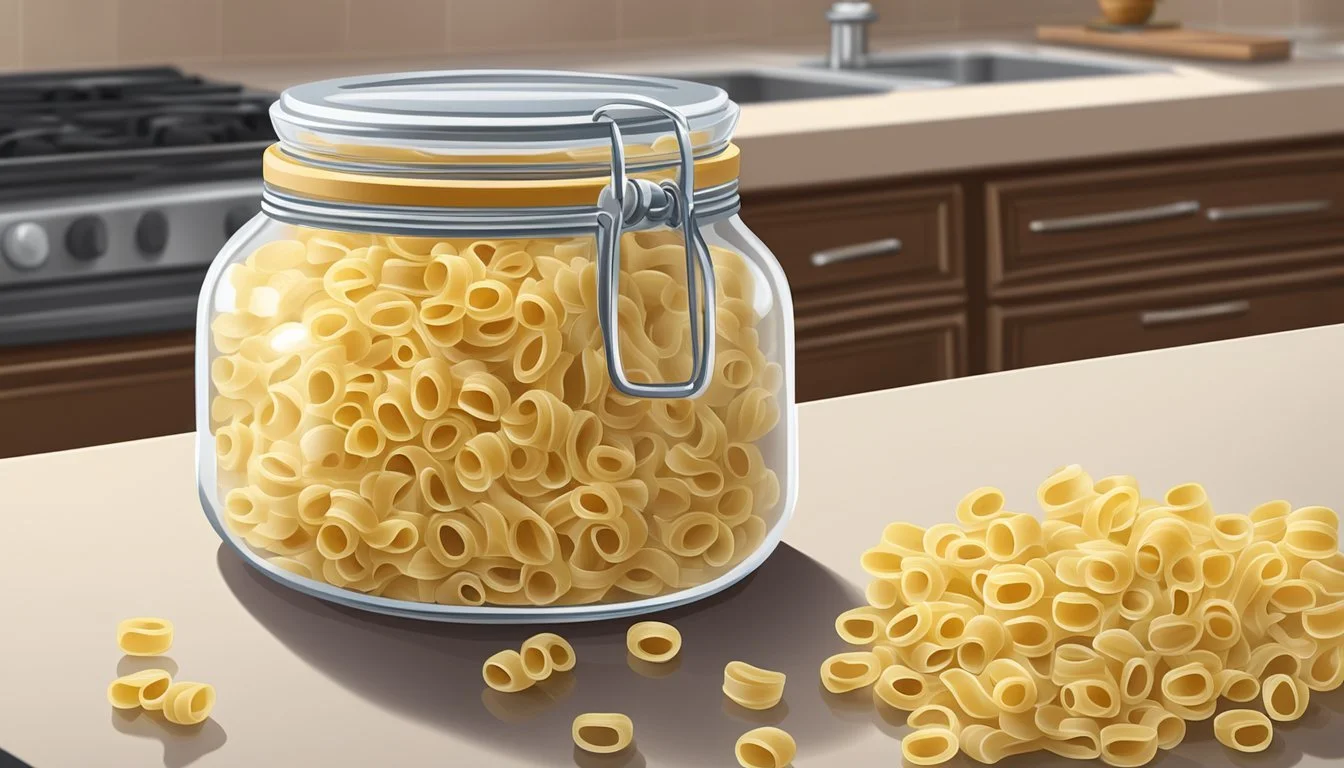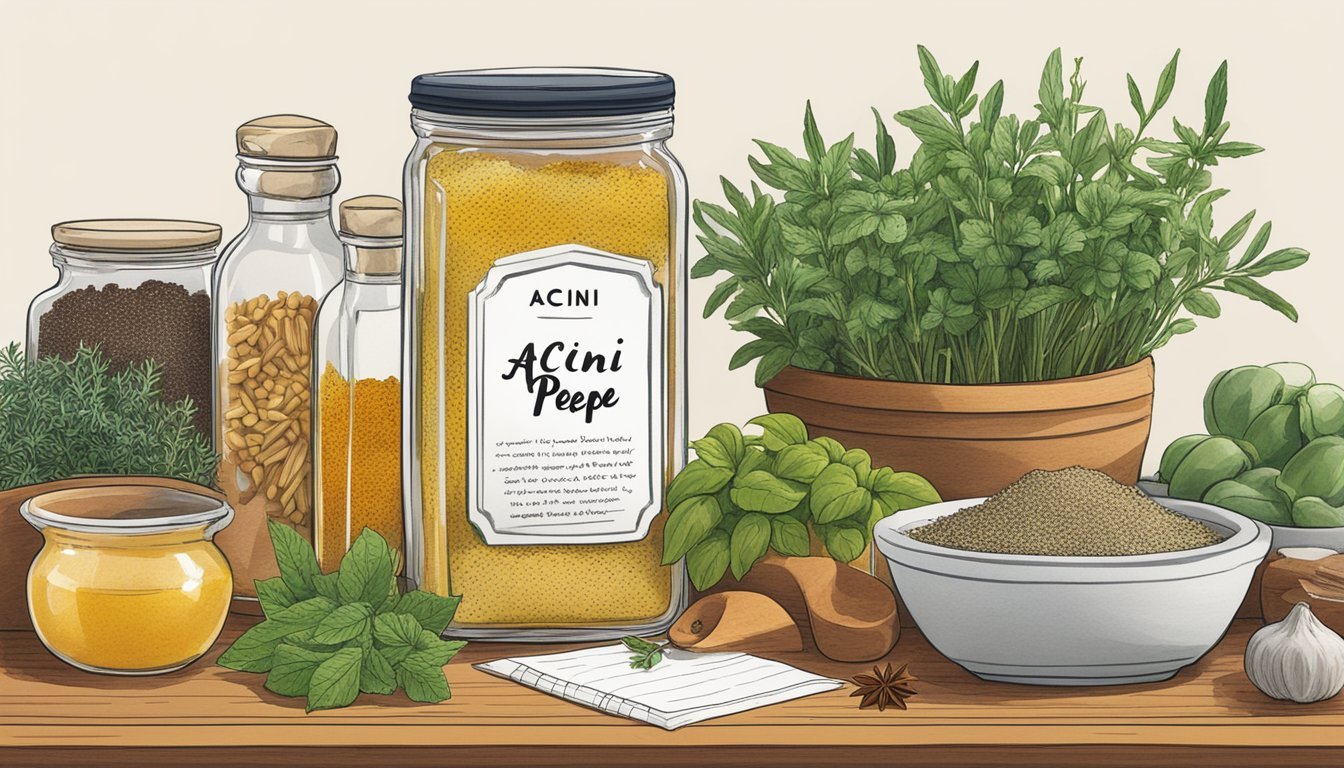How Long Do Acini Di Pepe Last?
Uncovering Pasta Shelf Life Secrets
Acini di Pepe is a type of pasta (What wine goes well with pasta?) known for its small, round shape, resembling peppercorns, hence its name which translates to "seeds of pepper" in Italian. Typically used in soups, salads, and occasionally in desserts, its storage and shelf life are similar to those of other dried pasta varieties. When stored properly in a cool, dry place within an airtight container, Acini di Pepe maintains its quality for a considerable period due to its low moisture content which makes it less susceptible to spoilage.
The shelf life of Acini di Pepe varies depending on whether it is dry or cooked. Unopened, dry Acini di Pepe can last up to two years, retaining its optimal quality if stored in a pantry. Once the package is opened, it is best used within one year to enjoy its peak flavor and texture. However, it is still safe for consumption beyond this period as long as there are no signs of spoilage, although the quality may decline.
Cooked Acini di Pepe, however, has a significantly shorter lifespan due to the introduction of moisture which can promote bacterial growth. When stored in the refrigerator in an airtight container, cooked Acini di Pepe pasta should be consumed within approximately three to five days. To extend the shelf life further, cooked pasta can be frozen and used within two to three months, a tip that helps in reducing food wastage and allows for meal preparation in advance.
Understanding Acini Di Pepe
Acini di Pepe is a small, round pasta that stands out within the broad category of pastina, recognized for its quick cooking time and distinctive texture that complements a variety of dishes.
Characteristics of Acini Di Pepe
Acini di Pepe, translating to "peppercorns" in Italian, resembles small beads, smaller than a grain of couscous (What wine goes well with couscous?). They are made from semolina flour (how long does semolina flour last?), a granular product of durum wheat, which contributes to its firm texture when cooked. Due to this pasta's size and composition, it possesses a unique ability to absorb flavors, making it an ideal choice for soups and salads.
Acini Di Pepe Versus Other Small Pasta Varieties
When comparing Acini di Pepe to other small pasta varieties such as pastina, couscous, and orzo, (how long does orzo last?) (c) it's notable for its round shape and lesser size. While couscous is crushed durum wheat semolina moistened and formed into small granules, and orzo mimics the shape of rice grains, Acini di Pepe maintains a distinct, spherical form. In terms of usage, both couscous and orzo can serve as substitutes in dishes that traditionally incorporate Acini di Pepe, yet the resulting texture and interplay with sauces or broths will vary.
Storage and Shelf Life
Proper storage is essential to maximize the shelf life of acini di pepe pasta. This section will detail how to store the pasta, how long it can be expected to last, and how to identify when it is no longer suitable for consumption.
Optimal Storage Conditions for Dry Pasta
Acini di pepe pasta should be stored in a cool, dry pantry away from sources of heat and light. To preserve quality, it's advisable to transfer the pasta from its original packaging to an airtight container. This helps protect it from moisture and pests, which are primary causes of spoilage and quality degradation.
Shelf Life of Acini Di Pepe
In the proper storage conditions, dry acini di pepe pasta can remain edible for up to two years. However, its best quality is maintained if consumed within one year. Adding a few drops of olive oil to the pasta after cooking can help prevent sticking if it is to be stored cooked, though this method is less common and the shelf life for cooked pasta is significantly shorter.
Signs of Spoilage
To determine if acini di pepe pasta has spoiled, one should look for:
Changes in color: Any discoloration may indicate mold or other spoilage.
Off-odors: Any unusual smells can be a sign that the pasta should not be consumed.
Pest infestation: Presence of insects in the packaging.
It's crucial to discard pasta if any of these signs are detected to avoid consuming spoiled food.
Preparation Tips and Techniques
When preparing Acini Di Pepe, it's crucial to achieve the right texture and ensure the pasta doesn't stick together. Using the proper amount of water, and knowing when to add salt and oil, can make a significant difference in the cooking process.
Boiling Acini Di Pepe for Optimal Texture
For optimal texture, the acini di pepe should be boiled al dente. This means that the pasta is cooked through but still holds a slight firmness to the bite. The steps are:
Fill a pot with water: Use about 1 liter of water per 100 grams of pasta.
Bring to a boil: Heat the water until it is at a rolling boil.
Add salt: Once boiling, add a generous pinch of salt to the water. This enhances the pasta's flavor.
Add the pasta: Gently stir in the acini di pepe.
Stir occasionally: Keep the water boiling and stir occasionally to prevent sticking.
Test for doneness: Start tasting the pasta after about 5 minutes of cooking. Each brand of acini di pepe may vary slightly in the required cooking time.
Preventing Acini Di Pepe from Sticking Together
Here are several tips to prevent acini di pepe from sticking:
Stir the pasta: Regular stirring throughout cooking can prevent clumping.
Use boiling salted water: Always start with boiling salted water to keep the pasta from sticking and to season it.
Consider oil: Drizzling a small amount of oil after draining can help keep the pasta separate. However, do this sparingly, as too much oil might prevent sauce from adhering to the pasta effectively.
Rinse after draining: For cold pasta dishes, rinse the acini di pepe with cold water to stop the cooking process and remove starch that causes sticking.
By following these preparation tips and techniques, one can ensure that Acini Di Pepe is cooked to perfection, capturing the essence of this classic Italian pasta.
Cooking with Acini Di Pepe
Acini Di Pepe, a small round pasta, is versatile in the kitchen, acting as an excellent ingredient for soups and salads, as well as a delightful accompaniment in various dishes. Its texture adds a pleasant contrast to recipes while offering a comforting, wholesome addition to meals.
Acini Di Pepe in Soups and Salads
Soups: Acini Di Pepe is commonly used in Italian soups where it provides a satisfying bite without overpowering the dish. For a classic Italian comfort food experience, one might add Acini Di Pepe to a chicken broth-based soup with Italian herbs, creating a simple yet flavorful meal. Cooking time in soups is typically around 8 minutes, ensuring the pasta retains a firmness, or 'al dente' quality.
Salads: When included in pasta salads, Acini Di Pepe absorbs dressings and seasonings well, enhancing the overall taste profile. To maintain the pasta's structure in salads, it should be cooked 3 to 5 minutes and then rinsed with cold water to prevent further cooking. By doing so, the pasta will mix well with ingredients like olives, offering a healthy and refreshing option particularly suited for warmer climates.
Acini Di Pepe as an Accompaniment
Acini Di Pepe can act as a subtle yet impactful accompaniment to dishes, similar to rice or couscous. When used as a side, it complements the main ingredient by taking up the flavors of the sauces or seasonings it's paired with. Cooking for 8 to 10 minutes until 'al dente' is recommended, after which the pasta can be dressed with a bit of olive oil to prevent sticking. This tiny pasta makes for an excellent side in one-pot meals, absorbing the essence of the pot's contents while contributing its own delectable texture.
Recipes and Flavor Pairings
Acini di pepe's petite size and texture make it remarkably versatile for absorbing flavors in both soups and salads. Its quick cooking time in broth or water allows for convenient meal preparations.
Classic Italian Wedding Soup With Acini Di Pepe
Italian Wedding Soup is a beloved classic where acini di pepe plays a central role. Key ingredients such as lean ground beef, Parmesan cheese, and spinach are essential for authenticity. When preparing this soup, one should:
Begin by forming small meatballs with beef, Italian herbs, Parmesan, breadcrumbs, and egg.
Heat olive oil in a pot and sauté the meatballs until browned.
Clear the pot and sauté additional aromatics like garlic, onions, and carrots.
Deglaze the pot with a splash of white wine, add chicken broth, and bring to a boil.
Stir in the acini di pepe, letting it cook until al dente.
Finish with fresh spinach and a seasoning of kosher salt (how long does kosher salt last?) and cracked peppercorns.
Creating a Mediterranean-Inspired Pasta Salad
A Mediterranean Pasta Salad incorporating acini di pepe brings a fresh and zesty profile to the table. To achieve the best results, incorporate ingredients such as:
Feta cheese, crumbled for rich, tangy bites.
Kalamata olives and chickpeas for a hearty texture.
Fresh lemon zest (how long does lemon zest last?), lemon juice, and olive oil whisked together for a vivacious dressing.
Toss the cooked acini di pepe with the dressing and ingredients.
Garnish with parsley, toasted pistachios, or a sprinkle of Parmesan cheese for extra flavor layers.
Pair the pasta with crisp white wine and crusty bread to enjoy a complete Mediterranean experience.
Health and Nutrition
When considering the health and nutrition of acini di pepe, one should focus on its nutrient content and suitability for various diets.
Nutritional Profile of Acini Di Pepe
Acini di pepe pasta is made from durum wheat flour, which imparts a specific nutrient profile. Durum wheat contributes to the pasta's caloric content while providing protein and a small quantity of dietary fiber. A standard serving of acini di pepe can be expected to contain:
Calories: Ranges from 200 to 300 calories per serving (approximately 1 cup uncooked).
Protein: A significant source, containing about 7 grams per serving.
Fiber: Typically lower in fiber, offering around 1 to 2 grams per serving.
It is essential to acknowledge that acini di pepe is not a significant source of vitamins or minerals. Its primary nutritional components are carbohydrates and protein, making it a viable energy source.
Dietary Considerations
For individuals with dietary restrictions, several factors concerning acini di pepe should be noted:
Gluten: Being a wheat-based pasta, it contains gluten and is not suitable for those with celiac disease or gluten sensitivities.
Health considerations: When integral to a balanced diet, acini di pepe can contribute to one's daily protein intake. However, due to its minimal fiber content, pairing it with vegetables or legumes can help enhance the fiber in a meal.
General diets: Acini di pepe's neutral nature makes it adaptable to various dishes but should be moderated in low-carbohydrate or calorie-restricted diets due to the high carbohydrate content.
In summary, while acini di pepe provides certain nutritional benefits, particularly in protein, its use in various diets may need to be adjusted according to individual health goals and dietary requirements.
Serving Suggestions
When serving acini di pepe, incorporating the right portion size and pairing with suitable garnishes can elevate the dish to its full potential.
Portioning and Servings
Acini di pepe is typically portioned at around 1/2 cup to 3/4 cup per serving when cooked. Given its small size, it expands considerably after cooking, so starting with about 1/4 cup dry per person is often sufficient.
For soups: Use 30g (1 oz) for a lighter soup and approximately 40g (1.5 oz) for a heartier variety.
For salads: 1 cup of dry pasta typically yields enough for about four servings.
Garnishes and Add-ins
The garnishes and add-ins bring a burst of flavor and texture to acini di pepe dishes. Here are some recommendations:
Olive oil: A drizzle of high-quality olive oil can prevent sticking and add a subtle, fruity flavor.
Cheese: Sprinkle with grated parmesan cheese to give a nutty and savory finish.
Vegetables:
Swiss chard adds a colorful and nutritious touch.
Lemon zest provides a refreshing citrus note.
Nuts (how long do nuts last?) and Herbs:
Toasted pistachios lend a delightful crunch.
Sage, crisped up in olive oil, imparts a warm, aromatic quality.
Spices: A pinch of red pepper flakes (how long do red pepper flakes last?) can offer a nice heat that contrasts the creaminess of parmesan.
When pairing these add-ins, consider the balance of flavors and textures to complement the pasta without overwhelming it.
Purchasing and Brands
When selecting acini di pepe pasta, individuals look for high-quality ingredients such as semolina wheat, which assures a satisfactory cooking experience. Comparing brands can help purchasers find the best quality and value within this specific type of pasta.
Selecting Quality Acini Di Pepe Pasta
The quality of acini di pepe, a tiny, round pasta, greatly relies on the ingredients. Semolina wheat, a key component, should be present for superior texture and flavor. Buyers should inspect packaging for semolina content and check for any signs of dampness or infestation which can compromise the pasta's integrity.
Brand Comparisons
Different brands offer acini di pepe pasta, and it is beneficial to compare them based on several factors:
Ingredient Quality: A brand that uses high-grade semolina wheat is often preferred.
Price: Comparatively priced brands might help in making an economic choice.
Reputation: Brands with positive reviews and a history of customer satisfaction are reliable choices.
For reference, here’s a simple Brand Comparison Table:
Brand Semolina Quality Price Point Customer Ratings Brand A High Moderate 4.5/5 Brand B Medium Low 4.0/5 Brand C High High 4.8/5
Purchasers might find that established brands provide consistency in their acini di pepe, assuring a dependable cooking result.
Cooking Times and Temperatures
Cooking Acini Di Pepe properly can make the difference between a well-prepared pasta dish and a culinary letdown. Accurate timing is crucial for achieving the desired texture, especially when aiming for al dente, which translates to "to the tooth" in Italian, indicating a firm yet tender bite.
Exact Cook Time for Al Dente Acini Di Pepe
For those looking to prepare Acini Di Pepe al dente, the cooking time is typically between 8 to 10 minutes. Begin by bringing a pot of salted water to a rolling boil before adding the pasta. Stir occasionally to prevent the individual pieces from sticking together. Testing the pasta at the 8-minute mark is advisable—it should yield a slight resistance when bitten.
Adjusting Cooking Time for Different Recipes
Different recipes may require adjustments in cook time for Acini Di Pepe:
Soup Recipes: Reduce the cooking time by 1-2 minutes from the al dente time, as the pasta will continue to soften in the hot broth.
Pasta Salads: Cook the pasta at the lower end of the al dente range and rinse with cold water to stop the cooking process. This helps retain texture in a cold dish.
Always refer to the specific recipe at hand for best results, as ingredient proportions and cooking methods can affect the optimal cooking time.










